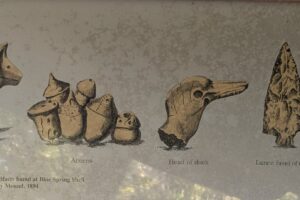In the 2 museums we’ve gone through with you so far in this area, we kept coming across the town of Pembina, the earliest settlement in the Dakotas. Well, here we are. This town/settlement in the far NE corner of the state, 2 rivers join each other, started in 1797 because of the fur traders.

In contrast, Cavalier settlement (the town closest to where we’re staying at Icelandic State Park) was founded in 1875. If you’d like more background information on these 2 towns, be sure to read to the end of this post. Their backgrounds are really interesting.



When we ended up in the Cavalier Hospital’s ER later on that day after my fall, we found out that the staff knows her well since she’s like a well-loved institution in the county. We’re so glad we got to know her!

From Wikipedia, “A sun dog (or sundog) or mock sun . . . is an atmospheric optical phenomenon that consists of a bright spot to one or both sides of the Sun.” See these spots on both side of the sun in this picture? Now we understand the name of the exhibit.
view from the tower


As we’re looking out over the land, the next 3 signs show us what we’re looking at as we go from left to right.

In 1822, Fort Pembina included 2 company forts. Fort Daer settlement on the left was built in 1797 as Fort Panbian. Pembina House on the right was built in 1803. This pen-and-ink illustration was done in 1822.



If you’re interested in more information about when and why Canada’s Northwest Mounted Police were founded, you may want to check out post 9 from when we were on Prince Edward Island (PEI) during our Canada! trip.


MCI is North America’s leading manufacturer of intercity coaches serving charter and tour operators, line-haul and scheduled-service operators, transit agencies, and conversion companies in the U.S. and Canada.





sundog and sunflower display
Now we get to learn about some of the folklore and folk art of those living in the northeastern part of North Dakota.

After midnight mass on Christmas Eve, someone would cut an onion into 12 slices and put a piece of salt into each slice. The slices represented the 12 months of the year. In the morning, the wettest slice would represent the wettest month of the coming year. We might try this ritual this Christmas!

As we drove around northeastern North Dakota, we kept seeing fields of sunflowers. Someone told us that these plants were for sunflower oil, not the sunflower seeds we eat. Here’s a real story about sunflowers in northeastern ND.
In the 1970s, sunflower production and activity in ND took off at the Farmers Elevator in Grace City (population was 63 at the 2010 census), just south of where we are. The owners of the elevator, Kenneth and Almyra Topp, began providing meals for the truck drivers delivering or hauling crops and soon opened the Sunflower Café across the road.
Their manager and cook in the 1970s and 1980s, Alice Scanson, built on the culinary history of sunflowers by adding special items to the menu: sunflower cookies and bread, sunflower pancakes topped with sunflower ice cream, and sunflower pie (similar to pecan pie.)

In the winter, children would make a big circle in the snow and then would cut 2 paths across the whole circle, leaving 4 pie shapes. The person who was “it” was the fox and would try to catch the others who were the geese. Everyone had to stay on the paths. A tagged goose went to the center to be the fox, and the game started all over again.


I found her obituary online and though you might like to see some of it. She died in February 2020 at the age of 97.
“After her husband passed away in 1981, Audrey thrived in her own way – always keeping busy, never feeling sorry for herself. She had a love and boundless talent for many things, including quilting, crocheting, gardening, and perhaps the most well-known, making lefse. She could almost always be found at her Kathryn home, working in her beautiful garden, stitching a complex quilt, or rolling seemingly endless lefse rounds. She sold her lefse at the local café, as well as shipping it all over the US. She even sold her lefse in Norway! She was known as one of the ‘Lefse Ladies.’”

A snow blizzard and freezing rain, followed by a quick thaw days later, contributed to the rapid rise of the Red River that flooded Grand Forks, ND, and East Grand Forks, MN, on April 18. International news was made as 50,000 people were evacuated, 60,000 were forced out of their homes, and a related fire destroyed a large part of downtown Grand Forks, ND.

Interested in curling? Here’s more information that you probably ever wanted to know. At least you’ll have more appreciation for this sport at the next Winter Olympics.
- The curling broom is used to sweep across the ice as the stone travels down.
- A curling stone weights between 38 and 44 pounds.
- The stone is a thick disc with a handle on the top. Each 4-man team has its own colored stone handle to distinguish it from other teams.
- The stone’s very shiny, polished surface helps it glide over the ice.
- The stone’s official dimensions include a maximum circumference of 36 inches and a height of at least 4.5 inches.
- Today the most popular curling stones are made from granites quarried in just two locations: 1) Ailsa Craig, an island in the Firth of Clyde, the channel between Ireland and Scotland; and, 2) the Trefor Granite Quarry, located on the coast of Wales.
- Kays of Scotland curling stones are the only stones used in competition by The World Curling Federation. Founded in 1851, and still manufacturing in Ayrshire Scotland, Kays Curling has the exclusive rights to harvest granite from Ailsa Craig. The qualities that make Ailsa Craig Granite unique are some of the main reasons that these curling stones are the preferred choice around the world.
Now you know all about the sport of curling!

how the towns of Pembina and Cavalier began
Pembina (from Wikipedia)
“The Pembina area was historically at the borders of the territories of the Lakota, the Chippewa, and the Assiniboine American Indian tribes, who competed for hegemony. Their conflict increased beginning with the French introduction of firearms in the late 17th century as part of their goods traded for furs. The first known European visitors to the Pembina region were the French La Verendrye family in the early 18th century.
Pembina’s recorded history of European encounter extended for more than 200 years. Started by the French as a fur trading post for commerce with Native Americans, it was also tied to trade for American Bison. European trappers who hunted in the Red River of the North area frequently married Native women and often lived with local tribes at least part of the year. Their descendants became part of their hunting and trapping culture, and formed the ethnic group recognized in Canada as Metis people.
The settlement was associated with the histories of French Canada, the North West Company (NWC), the Hudson’s Bay Company (HBC), the Red River Colony, Battle of Seven Oaks, the Red River Rebellion, Assiniboia, and Manitoba. Through much of the nineteenth century, Métis families used the two-wheeled Red River ox cart trains to travel into the Great Plains, where the men would hunt bison and women would process the meat, skins, and bones. All parts were used for clothing, tepees, etc. Their regular trade routes became known as the Red River Trails. This area was part of the United States’ Dakota and Minnesota territories; and Canada-US border politics.
The first Icelandic immigrant settlement in present-day North Dakota was in Pembina County [around today’s town of Cavalier—remember the museum at Icelandic State Park?] in the late 1870s, when a colony of settlers from Iceland moved into the county from the New Iceland homesteads near Lake Winnipeg.”
The population of the town of Pembina itself (not counting those living on nearby farms) on the 2010 census was 592.
Cavalier (from Wikipedia)
“Cavalier was laid out in 1875 on open land. The city was named for Charles Cavileer, an early settler in Pembina County (a recording error accounts for the error in spelling, which was never corrected). A post office has been in operation at Cavalier since 1877. Cavalier was incorporated in 1902.
In the early 1970s, the city of Cavalier’s population quadrupled in size due to the U.S.’ anti ballistic missile program. This was in preparation of a nuclear attack on the U.S. during the Cold War with the Soviet Union.”
The population of the town of Cavalier itself, the county seat, on the 2010 census was 1302.
Now onto the museum itself!




